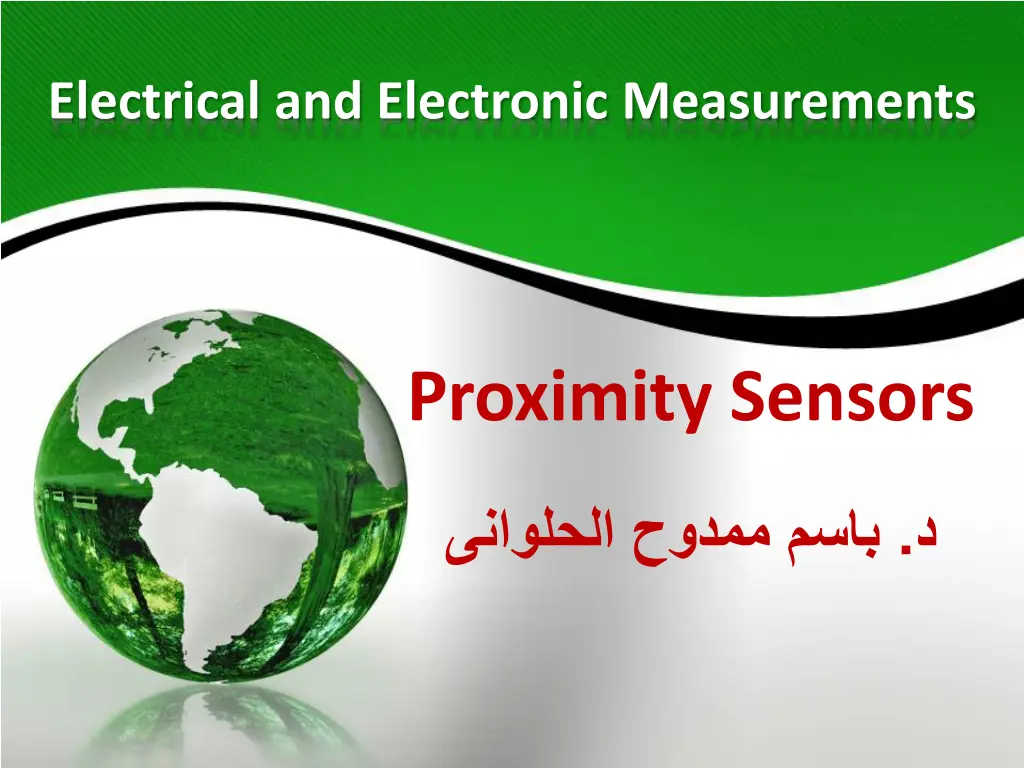
Understanding Proximity Sensors in Electrical and Electronic Measurements
Learn about the types and applications of proximity sensors in electrical and electronic measurements. Explore how optical sensors like photoelectric sensors play a crucial role in detecting objects using light. Discover the configurations and working principles of through-beam proximity sensors.
Download Presentation

Please find below an Image/Link to download the presentation.
The content on the website is provided AS IS for your information and personal use only. It may not be sold, licensed, or shared on other websites without obtaining consent from the author. If you encounter any issues during the download, it is possible that the publisher has removed the file from their server.
You are allowed to download the files provided on this website for personal or commercial use, subject to the condition that they are used lawfully. All files are the property of their respective owners.
The content on the website is provided AS IS for your information and personal use only. It may not be sold, licensed, or shared on other websites without obtaining consent from the author.
E N D
Presentation Transcript
Electrical and Electronic Measurements Proximity Sensors .
Proximity Sensors Proximity sensors detect the presence or absence of objects using electromagnetic fields, light, and sound. There are many types, each suited to specific applications and environments. Types of proximity sensors 1. Non-Contact Sensors : Optical Ultrasonic Inductive Capacitive 2. Contact Sensors (Mechanical) 2
Proximity Sensors 1. Optical (Photoelectric) proximity Sensors Photoelectric sensors are so versatile that they solve the bulk of problems All photoelectric sensors consist of a few of basic components: An emitter light source (Light Emitting Diode, Infra-red LED, laser diode), A photodiode or phototransistor receiver to detect emitted light, and Supporting electronics designed to amplify the receiver signal. Photoelectric proximity Sensors Configurations: 1. Through-beam 2. Retro-reflective 3. Diffuse 3
Optical sensors (Through-beam) Transmitter Receiver
Optical sensors (Through-beam) Transmitter Receiver
Optical sensors (Through-beam) Target Transmitter Receiver
Optical sensors (Through-beam) Transmitter Receiver
Optical sensors (Through-beam) Transmitter Receiver
Optical sensors (Through-beam) Transmitter Receiver
Optical sensors (Through-beam) Transmitter Receiver
Optical sensors (Through-beam) Transmitter Receiver
Optical sensors (Through-beam) Transmitter Receiver
Optical sensors (Through-beam) Transmitter Receiver
Optical sensors (Through-beam) Target Transmitter Receiver Long sensing distance: up to 30 metres with some devices Will detect all but very transparent materials Must be accurately aligned
Optical sensors (Retro-reflective) Type : Retro reflective T Transmitter /Receiver R Reflector (prismatic)
Optical sensors (Retro-reflective) Type : Retro reflective T Transmitter /Receiver R Reflector (prismatic)
Optical sensors (Retro-reflective) Type : Retro reflective T Transmitter /Receiver R Reflector (prismatic)
Optical sensors (Retro-reflective) Type : Retro reflective Target T Transmitter /Receiver R Reflector (prismatic)
Optical sensors (Retro-reflective) Type : Retro reflective T Transmitter /Receiver R Reflector (prismatic)
Optical sensors (Retro-reflective) Type : Retro reflective T Transmitter /Receiver R Reflector (prismatic)
Optical sensors (Retro-reflective) Type : Retro reflective T Transmitter /Receiver R Reflector (prismatic)
Optical sensors (Retro-reflective) Type : Retro reflective T Transmitter /Receiver R Reflector (prismatic)
Optical sensors (Retro-reflective) Type : Retro reflective T Transmitter /Receiver R Reflector (prismatic)
Optical sensors (Retro-reflective) Type : Retro reflective T Transmitter /Receiver R Reflector (prismatic)
Optical sensors (Retro-reflective) Type : Retro reflective T Transmitter /Receiver R Reflector (prismatic) Sensing distance : 1/2 to 1/3 of through-beam type Not suitable for reflective or transparent targets
Optical sensors (Diffuse) Target Type : Diffuse T Transmitter /Receiver R
Optical sensors (Diffuse) Type : Diffuse T Transmitter /Receiver R
Optical sensors (Diffuse) Type : Diffuse T Transmitter /Receiver R
Optical sensors (Diffuse) Type : Diffuse T Transmitter /Receiver R
Optical sensors (Diffuse) Type : Diffuse T Transmitter /Receiver R
Optical sensors (Diffuse) Type : Diffuse T Transmitter /Receiver R
Optical sensors (Diffuse) Type : Diffuse T Transmitter /Receiver R Sensing distance: much less than reflex type, actual distance depends on colour and reflective nature of the surface Larger targets result in longer sensing distances Not suitable for dirty environments
Non-contact Proximity sensors Inductive proximity sensor Capacitive proximity sensor C2 C1 P S C3 Capacitance increases as metal object (P) gets closer because additional capacitance paths C2 & C3 are added and increase in value as the separation reduces. C1 is always present. Coil inductance increases as iron / steel object (S ) gets closer 34
Non-contact Proximity sensors Ultrasonic (Sonar) sensors Ultrasonic sensor utilize the reflection of high frequency (20KHz) sound waves to detect parts or distances to the parts. In general, ultrasonic sensors are the best choice for transparent targets. They can detect a sheet of transparent plastic film as easily as a wooden pallet. Different Colors has no effect The most common configurations are the same as in photoelectric sensing: through beam, retro-reflective, and diffuse versions. 35
Non-contact Proximity sensors Ultrasonic (Sonar) versus IR sensors The primary difference is that sonar has a wide detection cone and longer range Unlike IR sensors, sonars are slightly harder to deal with when it comes to multiple sensors. Because of the wide cone, and how sound can reflect, they can interfere with each other quite easily. Typically, you must allow a 50ms between each firing of a sonar sensors, to let the ping die off. If you have multiple sensors, you can only ping one at a time, and must still obey this 50ms ring down time or have each sonar operating at a different sound frequency 36
